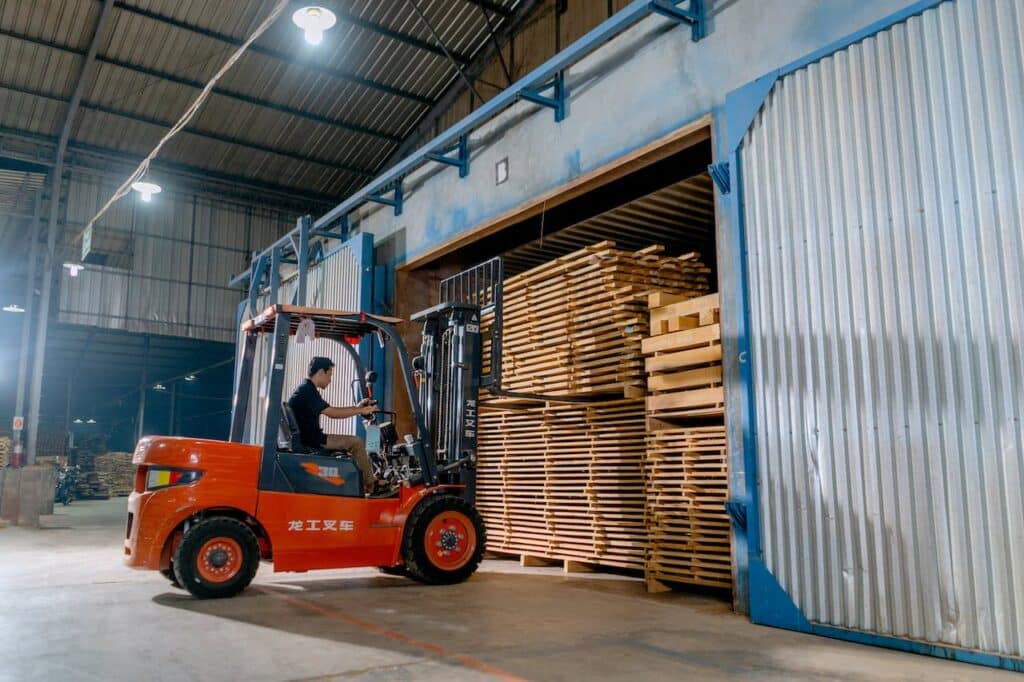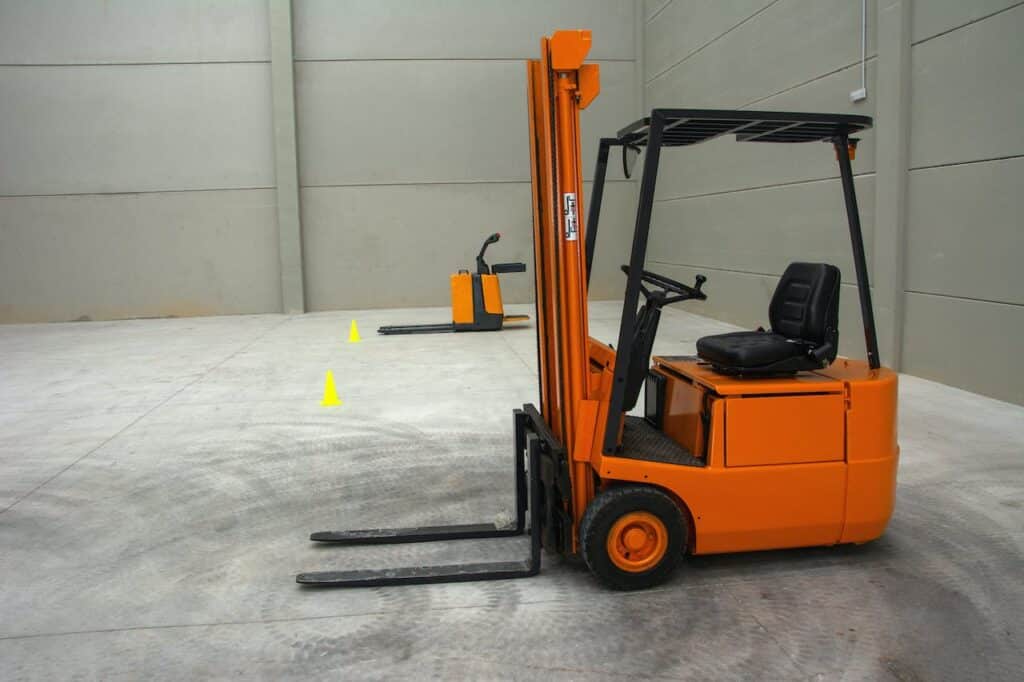In the fast-paced world of material handling, forklifts play a pivotal role in ensuring efficient and safe transportation of goods within warehouses and industrial settings. Sit-down counterbalance forklifts have become the go-to for many successful businesses.
When it comes to sit-down counterbalance forklifts, two prominent variants are the 4-wheel and 3-wheel sit-down counterbalanced models we supply as part of our range at Centra Forklifts. Each design comes with its own set of advantages and disadvantages, making them better suited for specific scenarios.
In this article, we will examine the intricacies of these forklifts. We will compare their features, benefits, and ideal use cases, drawing upon decades of experience in the logistics field.
Understanding 4-Wheel Sit-Down Counterbalance Forklifts:
The 4-wheel sit-down counterbalance forklift is a workhorse in many material handling applications. Characterised by its stability and versatility, this type of forklift is equipped with two front wheels and two rear wheels. The weight of the load is counterbalanced by the weight of the forklift itself, allowing for stability and ease of manoeuvrability.
The Mitsubishi Electric CB 4 Wheel 48V 1.8t is an example of this type of forklift.

Advantages of 4-Wheel Sit-Down Counterbalance Forklifts:
Stability and Lifting Capacity:
- One of the primary advantages of the 4-wheel design is its inherent stability. The weight distribution across four wheels ensures a solid base, making it suitable for lifting heavy loads with ease.
- The additional wheels contribute to a higher lifting capacity, allowing these forklifts to handle bulkier and heavier loads compared to their 3-wheel counterparts.
Manoeuvrability in Tight Spaces:
- Despite having four wheels, modern 4-wheel forklifts are designed with advanced rear-wheel steering systems that provide excellent manoeuvrability, even in confined spaces.
- Ideal for applications where space optimization is crucial, such as densely packed warehouses with narrow aisles that require heavy lifting.
Versatility Across Terrain:
- The 4-wheel sit-down counterbalance forklift performs well on various surfaces, including uneven floors or outdoor environments.
- Suitable for both indoor and outdoor applications, making them a versatile choice for businesses with diverse material handling needs.
Disadvantages of 4-Wheel Sit-Down Counterbalance Forklifts:
Increased Turning Radius:
- Due to the additional set of wheels, 4-wheel forklifts tend to have a larger turning radius compared to their 3-wheel counterparts.
- This may pose challenges in environments where tight turns are frequent, or space is limited.
Energy Consumption:
- The added weight and complexity of a 4-wheel forklift may result in higher energy consumption, impacting operational costs.
- Businesses focused on energy efficiency may need to weigh this factor against the benefits offered by the 4-wheel design.
- An extra wheel also adds to the maintenance components that may need replacing, during certain milestones in the forklifts life cycle.
Understanding 3-Wheel Sit-Down Counterbalance Forklifts:
The 3-wheel sit-down counterbalance forklift, as the name suggests, features two front wheels and a single rear wheel. This design emphasises manoeuvrability and is often chosen for applications where space is a premium, such as small warehouses. These warehouses are known to have densely packed shelves to maximise storage.
The Mitsubishi Electric Forklift CB 3 Wheel 48V 1.8t is an example of this type of forklift.

Advantages of 3-Wheel Sit-Down Counterbalance Forklifts:
Compact Design and Turning Radius:
- The compact nature of 3-wheel forklifts makes them highly manoeuvrable, especially in confined spaces or narrow aisles.
- Ideal for businesses with limited space or those requiring frequent navigation through tight corners.
Energy Efficiency:
- Due to their lighter weight and simplified design, 3-wheel forklifts are often more energy-efficient compared to their 4-wheel counterparts.
- Lower operational costs can be a significant factor for businesses aiming to reduce their carbon footprint and looking to perform less maintenance in order to keep their fleets operating like new.
Quick Acceleration:
- The 3-wheel design typically allows for faster acceleration and deceleration, contributing to increased productivity in certain applications.
- Well-suited for tasks that involve frequent stops and starts, such as loading and unloading in fast-paced environments.
Disadvantages of 3-Wheel Sit-Down Counterbalance Forklifts:
Reduced Stability and Lifting Capacity:
- The single rear wheel design may compromise stability, particularly when lifting heavy or bulky loads with a weight that may not be evenly distributed, emphasising the importance of making sure your staff are properly trained and licenced to operate these machines.
- Businesses with consistently heavy material handling requirements may find the lifting capacity of 3-wheel forklifts limiting.
Terrain Limitations:
- While 3-wheel forklifts excel in indoor settings with smooth surfaces, they may face challenges on uneven terrain or rough outdoor surfaces.
- Businesses operating in outdoor environments or transitioning between indoor and outdoor spaces should consider this limitation.
Choosing the Right Forklift for Your Needs:
The decision between a 4-wheel and 3-wheel sit-down counterbalance forklift depends on various factors, and understanding the specific requirements of your operation is crucial. Here are scenarios where one type may outshine the other:
Warehouse Layout and Aisle Width:
- For warehouses with narrow aisles and limited space, the compact design and tight turning radius of 3-wheel forklifts make them an excellent choice.
- Warehouses with wider aisles and a need for higher lifting capacities may benefit more from the stability and load-bearing capabilities of 4-wheel forklifts.
Indoor vs. Outdoor Applications:
- If your business primarily operates indoors and requires manoeuvrability through tight spaces, a 3-wheel forklift could be the optimal choice.
- For businesses that frequently transition between indoor and outdoor environments or deal with uneven surfaces, a 4-wheel forklift provides better versatility.
Load Characteristics:
- If your operation involves consistently heavy or bulky loads, a 4-wheel forklift with its higher lifting capacity is the more suitable option.
- Businesses dealing with lighter loads and requiring swift manoeuvrability may find the agility of a 3-wheel forklift advantageous.
Energy Efficiency Goals:
- Organisations focused on reducing energy consumption and operational costs may lean towards 3-wheel forklifts, given their typically higher energy efficiency.
- Businesses with a higher emphasis on lifting capacity and versatility may prioritise the advantages offered by 4-wheel forklifts despite potential energy trade-offs.
Choosing What Is Best for Your Needs: Sit-down Counterbalance Forklifts
In the dynamic landscape of material handling, the choice between a 4-wheel and 3-wheel sit-down counterbalance forklift is pivotal. This decision can affect both the efficiency and productivity of your operations.
Assessing the specific needs of your business and considering factors such as warehouse layout, load characteristics, and energy efficiency goals will guide you toward the optimal choice.
Both 4-wheel and 3-wheel sit-down counterbalance forklifts have their unique strengths, and by aligning these strengths with your operational requirements, you can make an informed decision that enhances the overall effectiveness of your material handling processes.
Have a chat with us at Centra Forklifts to see what forklift would be best for your business.
Call Centra on 0508 367 548 or, alternatively our team on:
Auckland: 09 634 8500
Waikato: 07 849 5128
Bay of Plenty: 07 282 9910
South Island: 03 343 6814
Lower North Island: 06 355 9033


